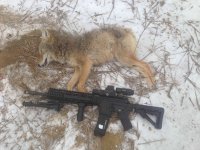What is wrong-headed is the idea that anything outside of a town is wilderness. It's not. It's someone's livelihood. Where I live is rugged country with mixed timber and meadow. The only thing it's good for is pasture and timber. I have a neighbor who, out of 100 bred ewes, lost all but 3 lambs to coyotes. It put him right out of the sheep business. Things are so bad that the last sheep slaughterhouse in the state closed 5 years ago, because there were no animals to keep it running. Most farmers and ranchers tolerate deer because they do minimal damage, but when a pack of wild dogs destroys the productive value of the land, those dogs have to go.
There is very little real wilderness anywhere near human habitation, or even far away. I understand that, and it is not what I said in any case. We have to do the best with what we have to work with. I don't consider wild/feral dogs as wildlife.
Thinking there is no possible method the rancher can use to raise sheep safely and profitably without eliminating predators is not true. It is a question of real costs being applied to the marketplace.
I realize that is no answer for the farmer going out of business. However, if you step back and realize that the attempt to raise sheep failed, likely while many predators were eliminated, then what is Plan B? Why not just accept that the wildlife, within reason, is and needs to be a part of the landscape and develop successful strategies? You can't pretend you are in New Zealand, or England and expect success.
How much would the cost of protection in the form of better fencing, guard animals, shepherds or whatever, add to the price of lamb on a per pound basis? The lamb in stores here is ridiculously over-priced now. That may be due to marketing or market development failures as good lamb is better eating than most people realize IMO.
However it happens, the market needs to reflect the value of ranching
and the value wildlife. They are both worth a lot. As it is, wildlife destruction is being treated as a zero cost, and yet you say there are not enough lambs to be viable. Double fail.
Those are the types of issues that conservation groups are wrestling with. In the East, conservation easements are purchased and donated that keep development (our worst predator) out of productive farm and timber lands. Maine is doing well in that area, probably because it has some of the least expensive land in the Northeast.
The key seems to be education. If people understand what is at stake, they are generally supportive. For Western lamb ranching, my guess is that ranchers are caught between low prices from Australia & New Zealand and the higher costs imposed by environmental concerns, and perhaps weather, here. I have never seen an attempt in this area to promote lamb like the beef, pork and dairy producers do. Building a market would do wonders for the situation.
Among many people in the East, Western ranchers carry a stereo-type of being willing and happy to shoot anything. That's bad for business. People don't believe they are trying hard enough to find balance. True or not, it's the perception or image that counts. That image is very tarnished.
We read about someone in Idaho bragging about shooting the first wolf. Or, elk hunters whining about the wolves. As far as I know, the wolf restoration has done wonders for the Yellowstone NP ecosystem, and I'm sure they eat plenty of elk--that was the plan. If my understanding is correct, those hunters don't give a hoot for conservation or wildlife; something hunters always claim to do.
We have our own issues with wolves, not many people are willing to accept them but they all know how terrible the coyotes are "eating all the deer." Never mind that the timber companies destroyed much of the wintering yards which weakens and concentrates the deer herd making them easy prey. Or, that a hard winter kills more deer than the coyotes ever will.
